By Joe Berk
An upfront warning: If you’re squeamish, you should skip this blog.
It rained hard after Tom, John, and I returned from our first day’s hunt, but that was okay. The Dunton Ranch has nice accommodations. Heat, hot water, cooking gear, refrigerator, shower, comfortable bunks, and more. Just bring food and ammo. It’s a gentlemanly way to hunt, and if nothing else, John and I are gentlemen. No more pitching tents and sleeping on the ground for us.
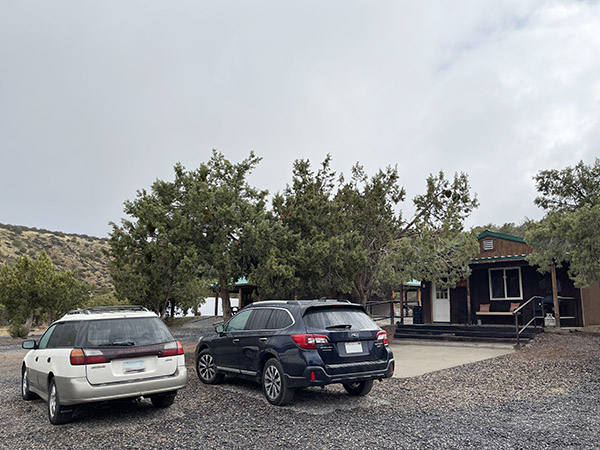
When Tom picked us up the next morning, he told me my hog weighed 219 pounds, and that he recovered the bullet. It had come to rest just inside the hog’s hide on the opposite side of where I shot it. I was very interested in seeing that bullet. Tom had prepped the hog and two sides of pork were hanging in the Ranch’s freezer. Tom told us he had stood outside in the rain the previous night skinning and dressing it. My pig weighed 219 pounds.
Tom showed me the bullet. My hog was a clean kill, but the bullet had failed. Its lead core separated from the cupper cup. Not that it made any difference to the pig.
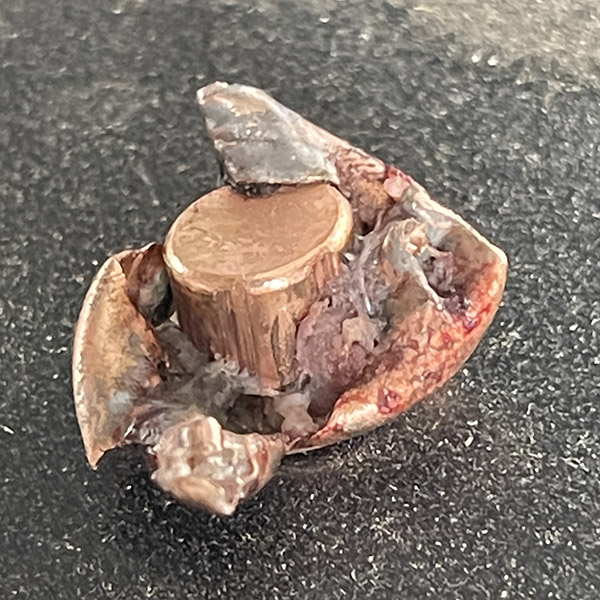
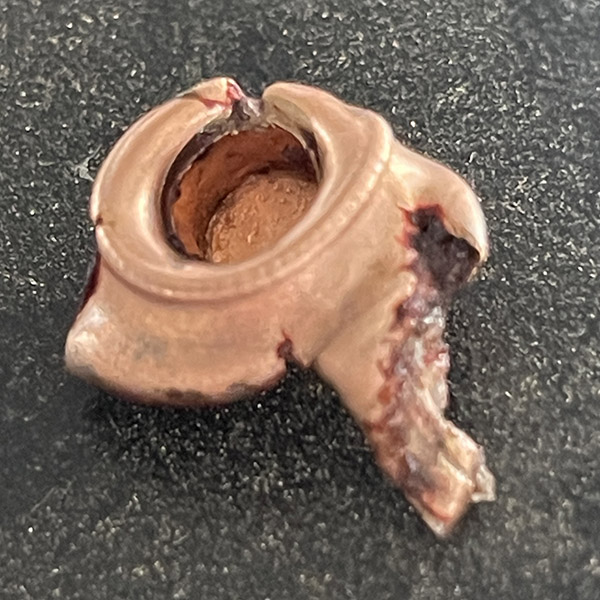
Tom told me the bullet had cleanly impacted the hog’s spine and taken out a fist-sized chunk of it. The hog was dead before it hit the ground, but the bullet had separated. It bothered me enough that I called Hornady when I returned home, and I’ll tell you about that later in this blog.
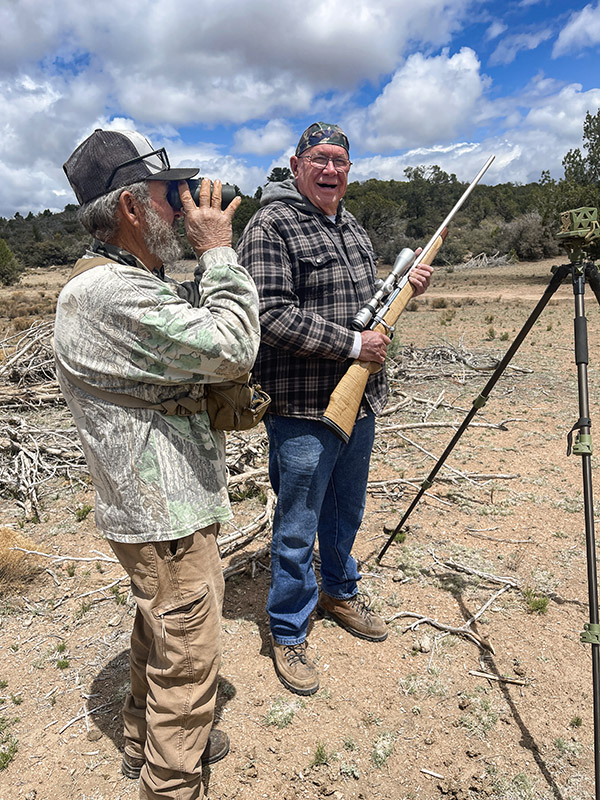
John’s rifle is a beautiful curly maple Browning A-Bolt chambered in .25 06. That’s a cartridge I had never owned, but not because I didn’t like it. Everything I’ve ever read about the .25 06 has been positive. Flat shooting, accurate, easy to find ammo and brass for…it has all the right things going for it and it rings all the bells. And I love A-Bolt Brownings. John’s rifle is all stainless steel, it has an octagonal barrel, and it wears a Nikon 3×9 telescopic sight finished in silver to match the rest of the rifle. It’s a beautiful firearm.
When John first bought his Browning several years ago, he visited us and we spent some time at the West End Gun Club zeroing it. John hadn’t shot the rifle too much since then, and he wanted to check the rifle’s zero before we hunted. Tom took us to a place where we could do so by firing at a pile of large boulders he knew to be a hundred yards away. John fired two shots and both hit exactly where he intended.
I took my Ruger with me again, but I already had my pig. I didn’t intend to shoot my rifle again unless we encountered a Russian boar.
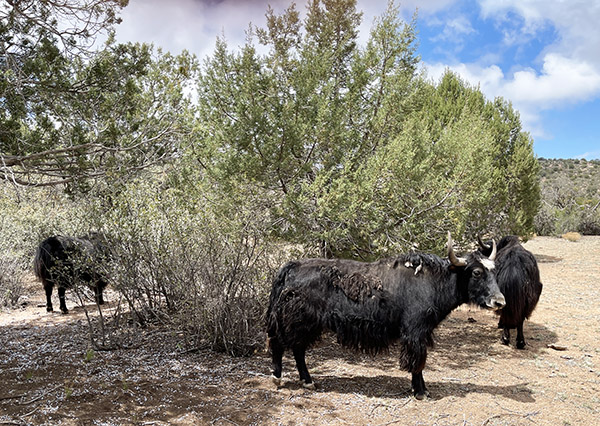
Although we had seen several Ossabaw hogs yesterday, none were around that second morning. Tom said he had been out earlier (before retrieving us) and he hadn’t seen any pigs, either. He said the previous night’s downpour most likely had driven them away. We did see several yaks and a bison. Dunton keeps a lot of game on his ranch. Neither John nor I had any desire to shoot one of these large animals.
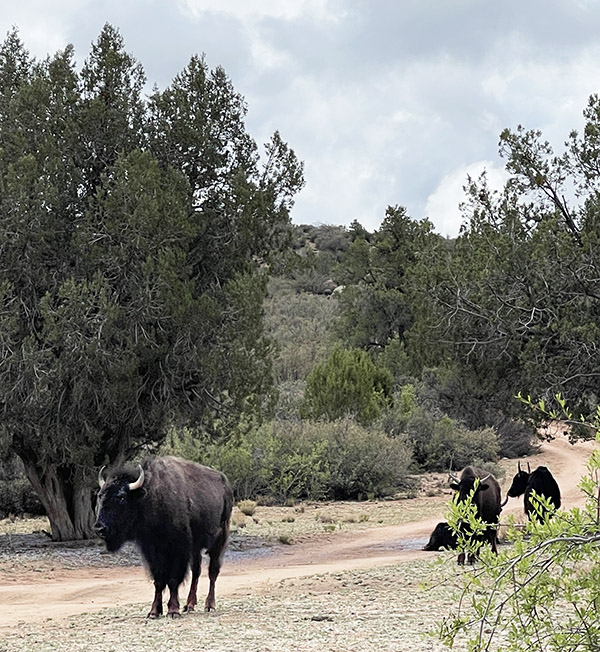
After riding around in the truck and walking most of the morning, we finally spotted several hogs. Tom scoped them and put the distance at 77 yards. It was John’s turn at bat and he took but a single swing. Just as had occurred the day before, all it took was one shot and it was game over. The .25 06 did its job.

When we walked up to the pig, we grabbed a few more photos, including the one of John and I posing behind his pig. It’s the photo you see at the top of this blog.
Tom asked if we’d like to go to one of the blinds and sit around waiting for a Russian to possibly stroll by while he dressed John’s pig. I asked if they would enter this part of the ranch with the Ossabaws present. “Yep, they will,” Tom said. “They’ll mate with the female Ossabaws.”
“I guess they’re not too particular,” I said. John, Tom, and I had a good laugh.
John said he’d like to go back and watch Tom dress his hog. Neither of us had seen that before. I realized I wanted to see it, too. We went back to the ranch proper, and wow, we really had our eyes opened. It’s not like you see meat at the supermarket, all neatly packaged and ready to go.
The first thing Tom showed us was my hog, all dressed out, with both sides hanging in the refrigerator. Tom pointed to where my bullet had hit the hog’s spine. The damage was staggering.
We went back outside and Tom used a Bobcat tractor to lift John’s hog out of the trailer. The hooks had a scale attached, and John’s hog came in at 225 pounds. He outdid me by 6 pounds (not that we were competing).
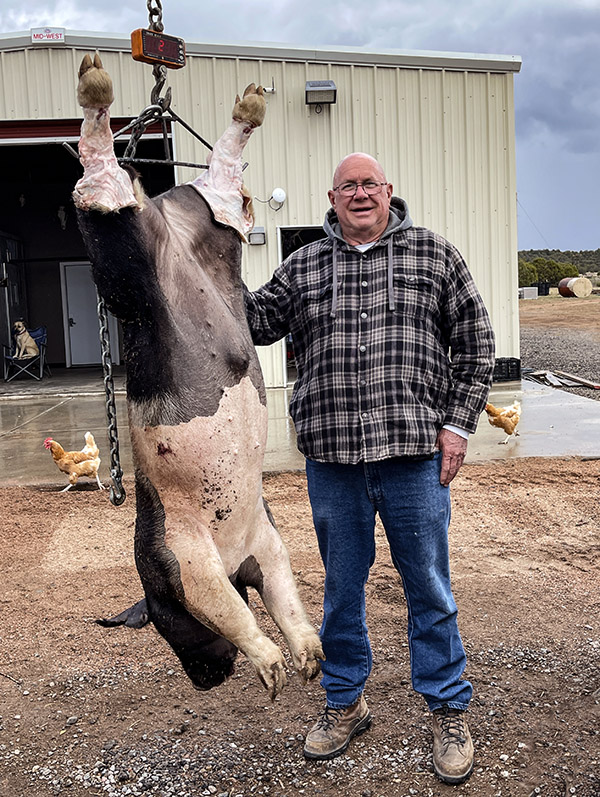
Tom went to work on the pig and what followed was amazing. I had no idea dressing out a hog was so labor intensive. It took Tom a good hour and a half, maybe more, to complete the job. It probably would have taken Tom less time if John and I hadn’t asked so many questions and taken so many pictures. All the while, chickens wandered into the area and were eating bits and pieces that fell off the hog as Tom worked on it. They’re carnivores, you know. There were turkeys strutting around, too, but they kept their distance (but not their silence). It was hard not to laugh as the turkeys gobbled up a storm at each other. It reminded me of what passes for political discussion these days.
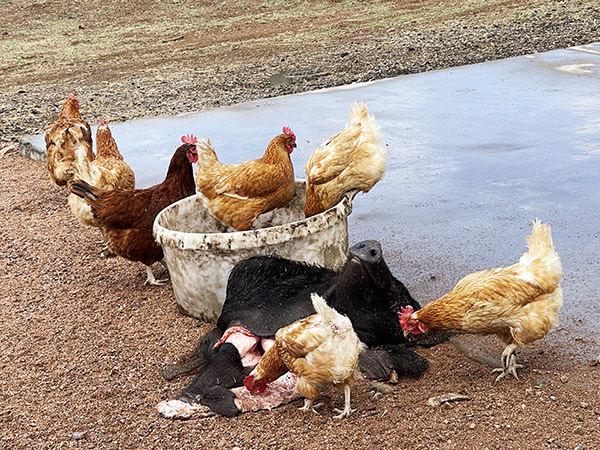
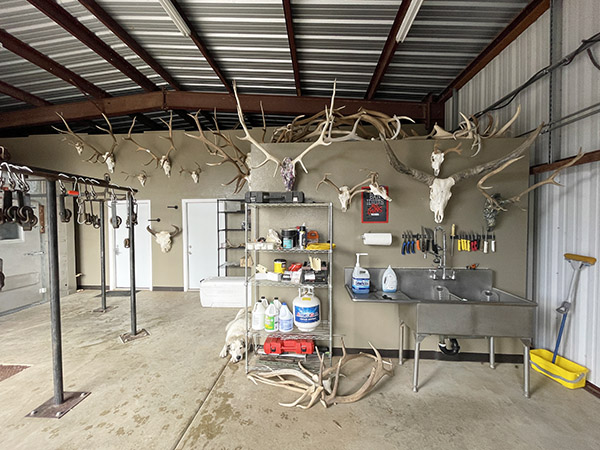
Tom finished up his chores on John’s hog and as he neared completion, he found John’s .25-caliber bullet. John used Federal factory ammo with 120-grain jacketed softpoint bullets. Unlike my Hornady bullet, the Federal bullet performed exactly as it was supposed to, mushrooming in a manner worthy of a bullet ad. It was located just under the skin on the opposite side of the hog.
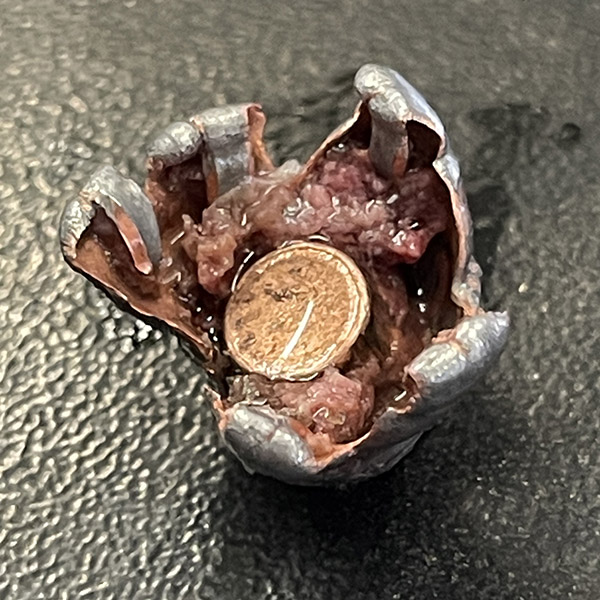
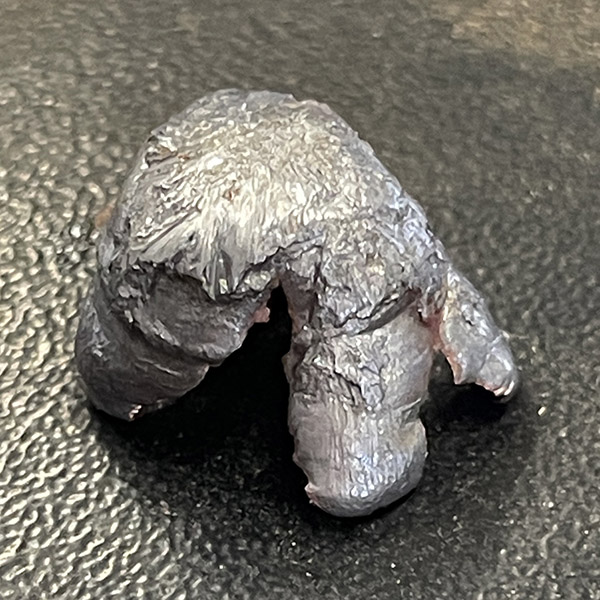
That night (which was only the second day we’d been on the Dunton Ranch), John and I decided to head into Kingman for dinner. We could have cooked in our cabin, but we were reveling in our pig-hunting success and we wanted to celebrate. Tom recommended a Mexican restaurant in town (El Palacio) and his recommendation was a home run.
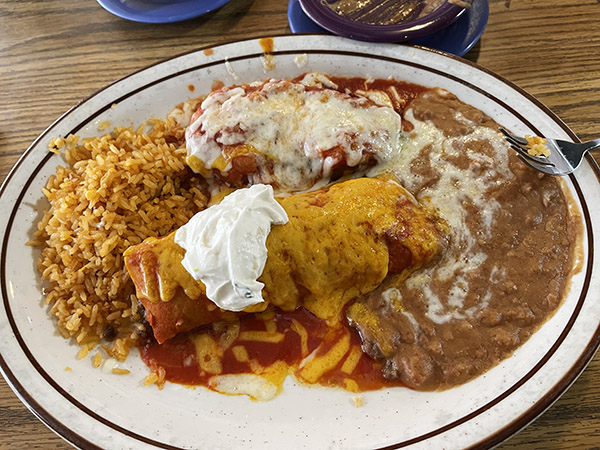

The ride home was enjoyable. It rained hard all night Tuesday and it rained as I was leaving Wednesday morning, but as soon as I passed Kingman I could see the skies clearing. It was an easy ride back to California. I stopped at Del Taco in Barstow and had a taco (they’re the best Del Taco anywhere).
Once I was home, I unpacked, ran a patch soaked in Patch-Out (my preferred rifle solvent) through the No. 1’s barrel, and then I called Hornady. I spoke with a nice guy there and told him what happened with my .30 06 bullet. “It happens,” he said. It’s more likely to happen, he went on, if the bullet is traveling at extremely high velocities or if the game was too close (before the bullet had a chance to slow). I explained that my .30 06 load’s muzzle velocity was just below 2900 feet per second (I knew this because I had chronographed the load, I explained) and the hog was a measured 117 yards away (and I knew this because our guide had a rangefinder). The Hornady man was impressed that I knew all that, and then mentioned that if a bullet strikes bone, it is also more likely to separate. Ding ding ding! That was exactly what happened on my hog.
The Hornady engineer told me that one way to avoid cup and core separation is to use a monolithic bullet (they are made of solid copper, with no lead core). He was almost apologetic when he explained that monolithic bullets are more expensive than lead bullets because copper costs more than lead. That may be my next step at some point in the future.
We are not allowed to hunt with lead bullets in California (the folks in our legislature are afraid that we might kill an animal, leave it, and then a California condor might eat it and get lead poisoning). You know, the California Condor, the super rare endangered species (that there are almost none of) might ingest an animal carcass with the remnants of a lead bullet fragment in it and die of lead poisoning. I’m serious; that’s what our politicians here in California are worried about. I shouldn’t be too hard on them, I suppose, because we have something in common. I and the rest of the TDS loonies here in California can both make this statement: None of us ever found any Russians. For the TDS-afflicted, it is imaginary secret agents in Moscow. For me, it is a Russian boar. My Russians are real, though, and on one of these trips, I’ll get one.
Anyway, it might be time to start experimenting with monolithic bullets. Maybe it’s a good thing we have that no lead law here in LooneyLand.
To get back on topic: Our hunt was a rousing success. The Dunton Ranch showed us a great time, and John and I each got our pigs. I can’t wait to do it again.
Missed Part 1 of the El Puerco story? It’s right here.
Join our Facebook ExNotes page!
Never miss an ExNotes blog:

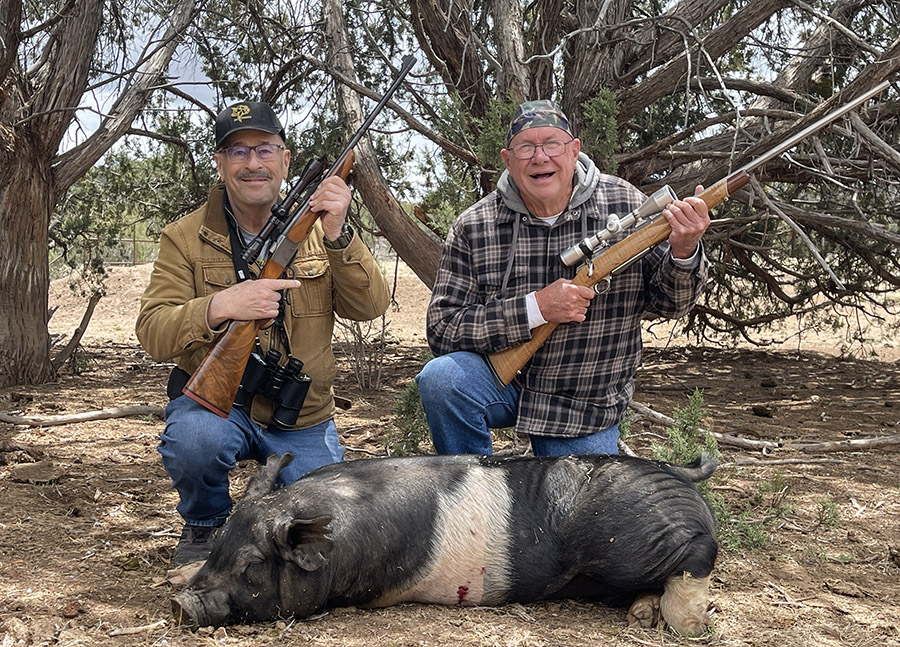

Mexican plate would hit the spot now! Looks awesome. Oh.. congrats on the hunt to…. but yeah Mexican…. lol
It was good!
Enjoyed this story about hunting with your Ruger No. 1 in 30-06. I just bought one in 300 H&H and hope to hunt with it this fall. Its dead on at 100 with the “express sights” and I’m mounting a Leupold 4.5×14 with Warne QD rings; will try to get it sighted in with the scope soon. These are really beautiful and handy rifles.
Best,
Craig
Good luck to you, Craig (both for your hunt and in finding brass). Love the .300 H&H cartridge. I have a No. 1 in that chambering but I have not fired it yet.